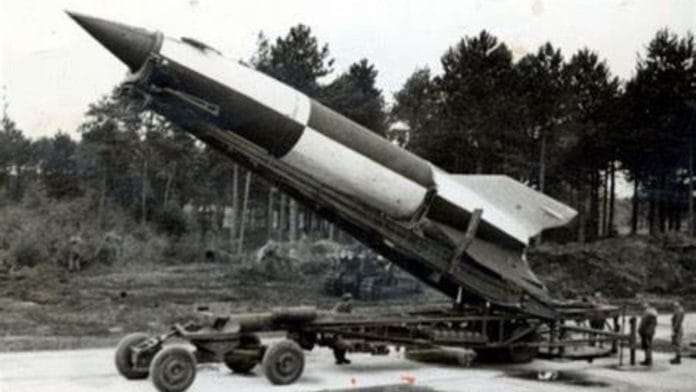Thank you dear subscribers, we are overwhelmed with your response.
Your Turn is a unique section from ThePrint featuring points of view from its subscribers. If you are a subscriber, have a point of view, please send it to us. If not, do subscribe here: https://theprint.in/subscribe/
The first ballistic missile was the V2 Rocket built by Germany for World War II during 1938 – 1945. Germans saw it as a rocket that would eventually turn the tide of the war against the Allies and do it at a strategic level rather than the tactical level. The tactical level of war is where attrition takes place on metre by metre of land that is contested. Strategic level of war is the cumulative of all the small battles, due to speed and tempo progressing at typhonic ferocity. And to overwhelm the enemy with mass fires (V2 campaign started in World War II in September 1944) in order to break enemy’s morale for fighting (either civilian and military people). The question then is why did Germany lose the Second World War? First reason was that V2 was delayed by three years, that is instead of coming into action in 1941, it came into being in 1944. This was because Hitler did not prioritize this strategic rocket early (in late 1930s) as back then he was winning wars including conquering France in 1940. Second reason was that the V2 was inaccurate in hitting the intended targets. Third reason was that the V2 was built by slave labor which was unskilled and that is why the rockets were of poor quality. Fourth reason was that Hitler was hell bent on not stationing these rockets on the road mobile launchers, instead he argued for static sites to be used for firing the rocket. This made the static sites sitting ducks for the Allied bombing campaign. Fifth reason was that since D-day in 1944 the Allied troops were moving towards Germany that is why the launching of V2 got completely out of range to hit its target (the V2 had a range of 190 kms). Atleast 3000 V2 fired, had little impact on the Allies. Since 2015 when the PLA Rocket Force was created by Xi Jinping, they have focused on increasing the numbers of conventional tipped missiles as much as they focus on nuclear tipped missiles. Even during the 1980s the Chinese had got conventional tipped missiles but they were few in numbers. Very few strategic affairs scholars are aware of the fact that the recently tested missile Dong Feng 41 by China in the international waters (Pacific Ocean) on September 25, 2024, this missile is an intercontinental ballistic missile (ICBM) that is dual use (can carry either a mounted nuclear and conventional bomb). Generally, people keep talking about it being a nuclear tipped missile only as they are unaware (page 287 of this book) it is a conventional tipped missile too [Hypersonic Glide Vehicle (HGV)]. The HGV is mounted on the ICBM. HGV combine speed and maneuverability to evade Ballistic Missile Defences. Any ballistic missile needs to be understood with respect to three technologies, that is propulsion, re-entry vehicles and guidance. For longer ranges as well as high accuracy missile, all of the three technologies do become even more complicated. All this happens as a longer range has to be attained for hitting a target, which is impossible without different stages. For India-China War, a single stage missile like the ‘Pralay’ ballistic missile restricts to tactical battles as its range is 500 kms. This becomes important to understand as the PLA will decide to wage a war of occupation with attacks focused not only on LAC but entire Ladakh, Sikkim and Arunachal Pradesh which China claims. So, on entire areas the PLARF missiles can rain down. Military expert Pravin Sawhney says “The PLA will build its Rocket Force missiles surge needed for India over time. Just as China took three years to prepare for the 1962 war even as its leaders were hoping for peace with India, preparations for large numbers of indigenous missiles will start early. Based on AI-enabled mathematical modelling of identified targets, and with automated production capability, the PLA will calculate the surge requirement for long range rockets, and smart and precision munitions including missiles, and build them. On the Indian side, the IAF inventory will be finite with little possibility of making up attrition rates.” The ballistic missiles of India, AGNI-II and AGNI-III (currently nuclear tipped) are capable of targeting anything in the entire area of Tibet. AGNI I-V missiles have to be mass produced as conventional tipped missiles and deployed for deterring war. When it comes to disengagement, optimistic coverage by Indian media is unlikely true, as Xi Jinping has displayed Mao Zedong type territorial expansion alike 1962 Chinese attack. So, military disengagement shall be approached with huge caution. If deterrence breaks down completely, then to win war quickly, India shall fire its conventional tipped missiles AGNI-V on Beijing, along with AGNI I-IV missiles to sow fear of defeat in the Chinese!
These pieces are being published as they have been received – they have not been edited/fact-checked by ThePrint


